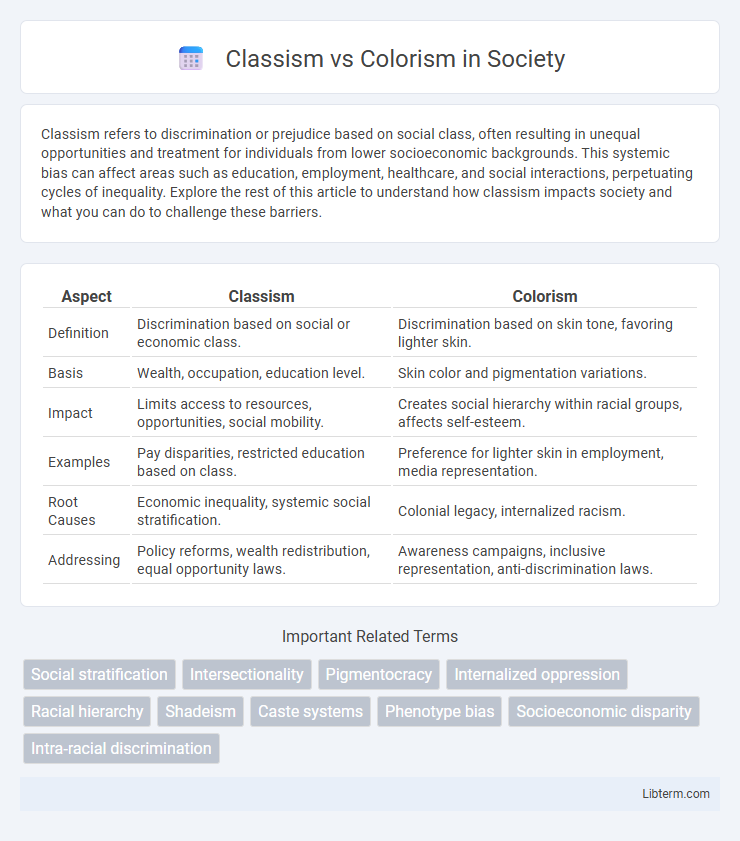Classism refers to discrimination or prejudice based on social class, often resulting in unequal opportunities and treatment for individuals from lower socioeconomic backgrounds. This systemic bias can affect areas such as education, employment, healthcare, and social interactions, perpetuating cycles of inequality. Explore the rest of this article to understand how classism impacts society and what you can do to challenge these barriers.
Table of Comparison
| Aspect | Classism | Colorism |
|---|---|---|
| Definition | Discrimination based on social or economic class. | Discrimination based on skin tone, favoring lighter skin. |
| Basis | Wealth, occupation, education level. | Skin color and pigmentation variations. |
| Impact | Limits access to resources, opportunities, social mobility. | Creates social hierarchy within racial groups, affects self-esteem. |
| Examples | Pay disparities, restricted education based on class. | Preference for lighter skin in employment, media representation. |
| Root Causes | Economic inequality, systemic social stratification. | Colonial legacy, internalized racism. |
| Addressing | Policy reforms, wealth redistribution, equal opportunity laws. | Awareness campaigns, inclusive representation, anti-discrimination laws. |
Understanding Classism: Definition and Origins
Classism refers to discrimination or prejudice based on social class, often manifesting in unequal access to resources, opportunities, and privileges between economic groups. It originates from historical systems of social stratification, including feudalism, capitalism, and colonialism, which entrenched economic and social hierarchies. Understanding classism involves recognizing how economic status influences power dynamics and perpetuates systemic inequalities across education, employment, and healthcare sectors.
Defining Colorism: History and Impact
Colorism, a form of prejudice favoring lighter skin tones within the same racial or ethnic group, originated during colonial eras when European powers imposed social hierarchies based on skin color. Its pervasive impact includes systemic disparities in employment, education, and social status, deeply affecting communities of color by reinforcing internalized biases and social divisions. The historical roots of colorism intersect with colonialism and slavery, shaping modern societal attitudes and perpetuating unequal opportunities and treatment.
Key Differences Between Classism and Colorism
Classism discriminates based on socioeconomic status, affecting access to resources, opportunities, and social mobility, while colorism involves prejudice or favoritism based on skin tone within a racial or ethnic group. Classism often manifests through economic barriers and systemic inequalities tied to wealth and education, whereas colorism influences social status, beauty standards, and interpersonal treatment linked to skin color gradients. Both forms of discrimination reinforce social hierarchies but operate through different criteria--economic class for classism and skin color for colorism--shaping experiences of privilege and marginalization.
Social Hierarchies: Class vs. Skin Tone
Classism enforces social stratification based on economic status, often dictating access to resources, education, and opportunities. Colorism, meanwhile, privileges lighter skin tones within racial communities, influencing social mobility and acceptance beyond pure economic factors. Both systems perpetuate inequality, yet classism primarily hinges on wealth and occupation, whereas colorism centers on skin color as a determinant of social hierarchy.
Historical Roots of Class and Color Discrimination
Classism and colorism both have deep historical roots linked to systems of power and social hierarchy. Classism originated from economic stratification and land ownership patterns that reinforced wealth disparities, while colorism emerged through colonialism and slavery, privileging lighter skin tones as symbols of proximity to dominant white ruling classes. These intertwined prejudices continue to shape social dynamics and access to opportunities across different communities.
Intersections: When Classism Meets Colorism
Classism and colorism intersect by compounding social inequalities where economic status and skin tone both influence opportunities and treatment within society. Darker-skinned individuals from lower socioeconomic backgrounds often face intensified discrimination in education, employment, and social mobility compared to their lighter-skinned or wealthier counterparts. This intersection perpetuates systemic barriers, reinforcing cycles of marginalization and limiting access to resources and social capital.
Modern Examples of Classism and Colorism
Modern examples of classism include disparities in education access, where low-income students face underfunded schools and limited college opportunities, perpetuating socioeconomic gaps. Colorism manifests in the beauty and entertainment industries, with lighter-skinned individuals often preferred for roles and endorsements, reinforcing discriminatory standards of beauty. Workplace hiring biases frequently blend classism and colorism, disadvantaging darker-skinned and lower-class candidates despite equal qualifications.
Cultural Factors Influencing Class and Color Bias
Cultural factors shaping classism and colorism include historical power dynamics, social hierarchies, and media representation that reinforce stereotypes and social divisions. Economic structures and colonial legacies often intertwine, perpetuating biases against lower social classes and darker skin tones within communities. Educational access and cultural narratives play critical roles in sustaining or challenging these prejudices across generations.
Combating Classism and Colorism: Strategies for Change
Combating classism and colorism requires implementing inclusive policies that promote equal opportunities in education, employment, and housing for marginalized groups. Community-led awareness campaigns and diversity training programs help dismantle prejudices rooted in socioeconomic status and skin tone. Legal reforms combined with economic empowerment initiatives foster systemic change, ensuring equity and social justice across societal structures.
Moving Forward: Building Inclusive Societies
Moving forward, building inclusive societies requires addressing both classism and colorism by implementing equitable policies that promote economic mobility and racial justice. Programs focused on education, fair housing, and employment must target systemic barriers affecting marginalized communities to foster equal opportunities. Emphasizing intersectionality ensures that efforts consider the complex ways class and color-based discrimination intersect and compound social exclusion.
Classism Infographic

 libterm.com
libterm.com